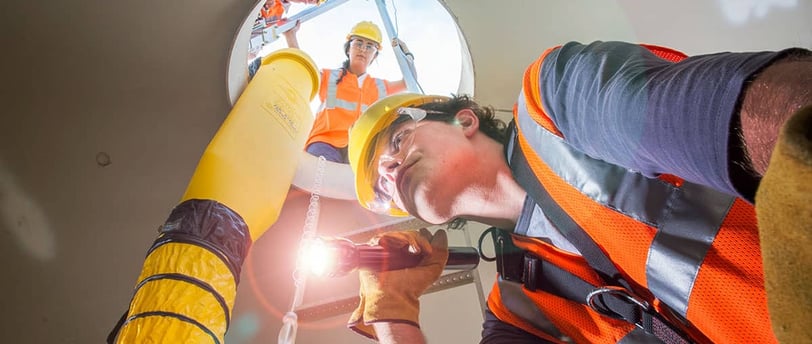
Thinking Inside the Box
Confined Spaces in Ontario


Confined spaces are present in a wide array of industries, from underground vaults and storage tanks to silos and pipelines. While they might seem like just another part of the job, working in these enclosed areas presents unique and potentially life-threatening hazards. In Ontario, the Occupational Health and Safety Act (OHSA) and its specific regulations, particularly Ontario Regulation 632/05 - Confined Spaces, lay out strict requirements to ensure the safety of workers entering these challenging environments.
What Exactly is a Confined Space?
According to the regulations, a confined space is a fully or partially enclosed area that meets all of the following criteria:
· Not designed or constructed for continuous human occupancy: These spaces are meant for occasional entry for inspection, maintenance, repair, or cleaning.
· Limited or restricted means of entry or exit: Getting in and out can be difficult, potentially hindering rescue efforts in an emergency.
· Potential for atmospheric hazards: This is the most critical factor. Confined spaces can accumulate dangerous gases, have oxygen deficiencies or enrichments, or contain flammable materials.
Why is Confined Space Work So Dangerous?
The inherent characteristics of confined spaces create significant risks:
· Atmospheric Hazards: This is the leading cause of injury and fatality. Toxic gases like hydrogen sulfide or carbon monoxide can be present. Oxygen levels can drop due to chemical reactions or displacement by other gases, leading to asphyxiation. Conversely, oxygen-enriched environments increase the risk of fire and explosion.
· Physical Hazards: These include engulfment (being trapped by liquids or solids), falls, entrapment, electrical hazards, and extreme temperatures.
· Isolation: Workers inside a confined space are often isolated and may not be able to easily communicate with those outside, delaying crucial help in an emergency.
The OHSA and Ontario Regulation 632/05: A Framework for Safety
Recognizing these dangers, the OHSA and Ontario Regulation 632/05 establish a comprehensive framework that employers must adhere to before any worker enters a confined space. Key requirements include:
· Hazard Assessment: Before entry, a thorough assessment of all potential hazards within the confined space must be conducted. This includes identifying atmospheric risks, physical hazards, and any other dangers.
· Confined Space Program: Employers are required to develop and maintain a written confined space program in consultation with the joint health and safety committee or a worker representative (if one exists). This program outlines procedures for safe entry, work, and exit.
· Entry Permits: For every entry into a confined space, an entry permit is mandatory. This permit must detail the identified hazards, precautions to be taken, required PPE, emergency procedures, and the names of authorized entrants, attendants, and supervisors. It must be signed by the supervisor before entry is allowed and made available to all individuals involved.
· Worker Training: Only trained workers are permitted to enter confined spaces. Training must cover hazard recognition, safe work practices, the use of monitoring and rescue equipment, and the procedures outlined in the confined space program. Ontario Regulation 632/05 specifies the need for adequate training for workers who enter, act as attendants, or perform rescue duties.
· Atmospheric Testing: Before entry and periodically during work, the atmosphere inside the confined space must be tested for oxygen levels, flammable gases or vapours, and toxic contaminants. Entry is only permitted if the atmosphere is deemed safe, and continuous monitoring may be required.
· Ventilation: If atmospheric hazards are present or likely to develop, the confined space must be properly ventilated to ensure a safe working environment.
· Rescue Procedures: A detailed rescue plan must be in place before anyone enters the confined space. This plan must outline the procedures for safely rescuing workers in an emergency, ensure that adequate rescue personnel are available, and that appropriate rescue equipment is readily accessible and in good working order.
Working Safely in Confined Spaces: A Shared Responsibility
Safe confined space work is a shared responsibility. Employers must provide the necessary training, equipment, and procedures, while workers must follow these procedures diligently. Never enter a confined space without proper authorization, training, and a valid entry permit. If you have any concerns about the safety of a confined space, voice them to your supervisor immediately.
Confined spaces don't have to be inherently dangerous. By understanding the risks, adhering to the regulations outlined in the OHSA and Ontario Regulation 632/05, and prioritizing safety above all else, we can ensure that everyone who enters these challenging environments returns home safely.
